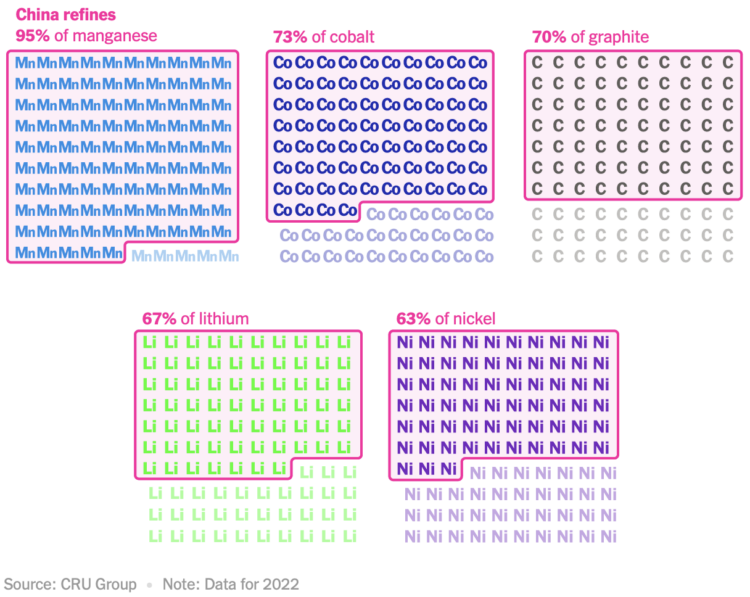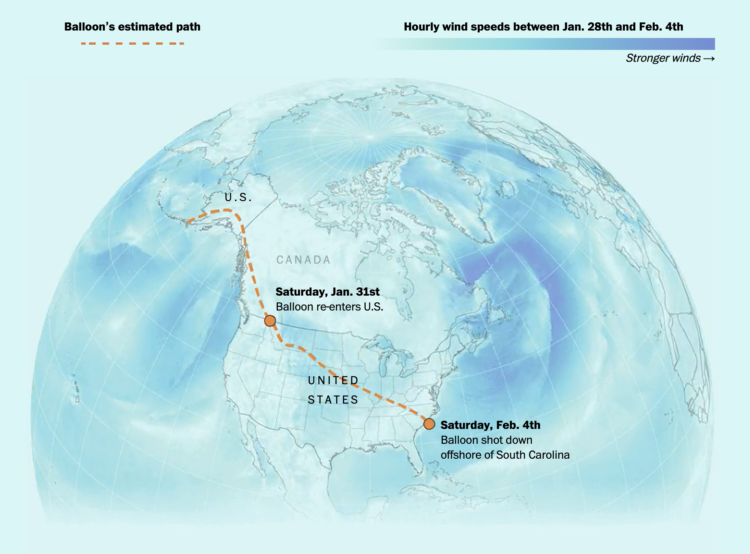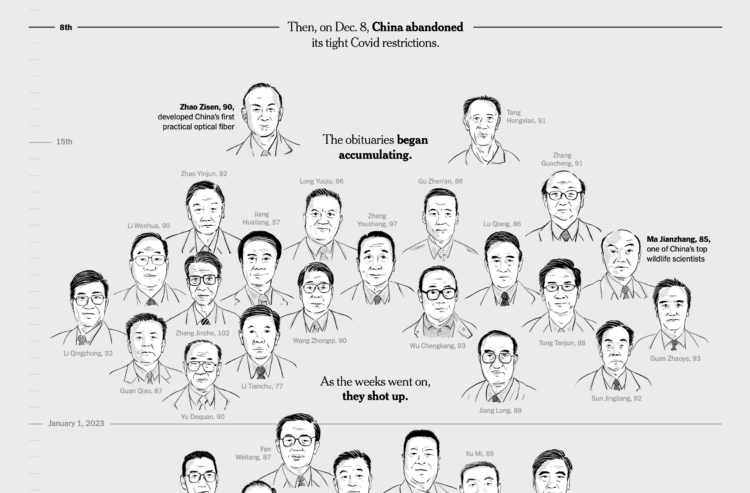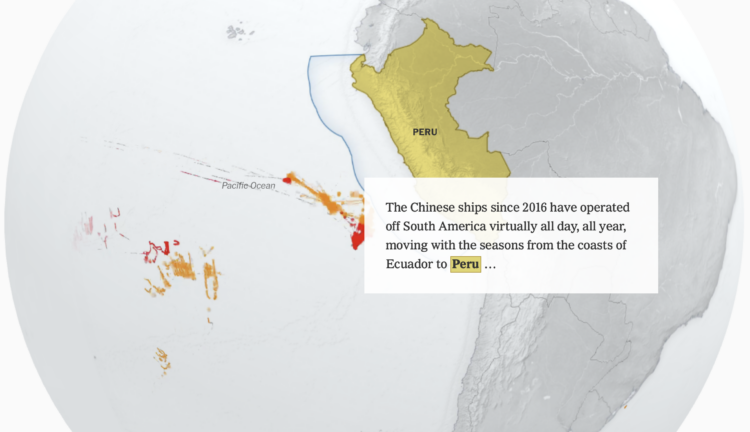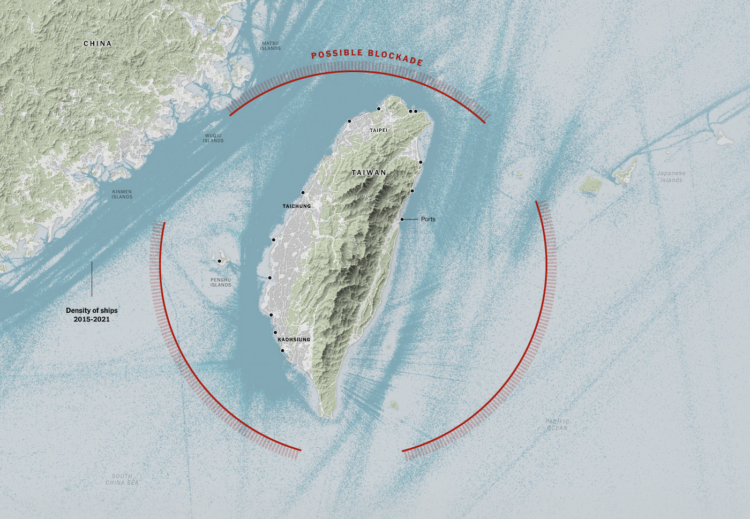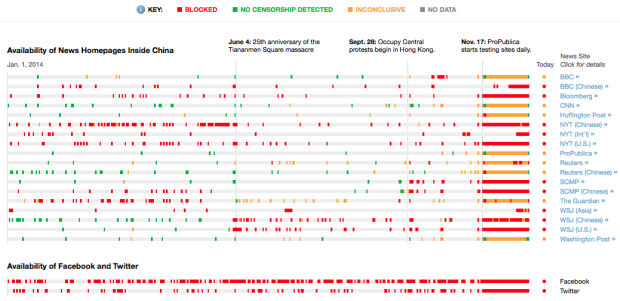Most of Apple’s suppliers and manufacturing happen outside the United States and in China. But because of tensions between the U.S. and China, Apple has tried to shift to other countries. Bloomberg provides the breakdowns over time, showing the biggest increases in India and Vietnam.
Tag Archives: China
To make electric vehicle batteries, China must be involved
For The New York Times, Agnes Chang and Keith Bradsher ask if it’s possible for the world to make EV batteries without China. Going over manufacturing and the materials involved, it looks like probably not:
Experts say it is next to impossible for any other country to become self-reliant in the battery supply chain, no matter if it has cheaper labor or finds other global partners. Companies anywhere in the world will look to form partnerships with Chinese manufacturers to enter or expand in the industry.
I appreciate the illustrative nature of these charts.
Tags: battery, China, electric vehicle, supply
Posted by in battery, china, electric vehicle, Infographics, supply
India estimated to pass China in population
Based on the United Nations’ world population report, it is estimated that India’s population will increase past China’s some time this year. For The New York Times, Alex Travelli and Weiyi Cai have charts to show how and why.
Tags: China, India, New York Times, population
Posted by in china, India, New York Times, population, Statistical Visualization
Shooting down the Chinese balloon
Shooting down a floating balloon out on its lonesome seems like a straightforward task. It’s just a balloon after all. But it seemed to take a while to get that Chinese spy balloon down. For The Washington Post, William Neff, Leslie Shapiro and Dylan Moriarty explained the challenges and timing behind the task.
Tags: balloon, China, military, Washington Post
Posted by in balloon, china, Infographics, military, Washington Post
Inferring the scale of China’s Covid spike through obituaries
China reported 80,000 Covid deaths since lifting restrictions in early December 2022. But researchers believe the count is much higher, because the figure only includes hospital deaths and the country does not require Covid testing as strictly as before. So, for The New York Times, Pablo Robles, Vivian Wang, and Joy Dong evaluated the change in scale of scholars’ obituaries, which appears to correlate with China’s restriction timeline.
Tags: China, coronavirus, deaths, illustration, New York Times
Posted by in china, coronavirus, deaths, illustration, Infographics, New York Times
China’s fishing patterns shift globally
China’s fish supply is running low along its own coast, so they’ve shifted their fishing activities globally. The New York Times visualized the shift with animated maps.
Tags: China, fishing, New York Times
Posted by in china, fishing, maps, New York Times
China’s possible blockade around Taiwan
It appears China wants to impose a blockade around Taiwan with ships, submarines, and airplanes. The New York Times mapped the possibility and how it could disrupt life in and around the island.
Tags: blockade, China, New York Times, Taiwan
Canceled flights due to coronavirus
With an animated side-by-side map, The New York Times shows canceled flights in efforts to slow down the spread of the coronavirus. The left map represents 12,814 flights within China on January 23. The right map shows 1,662 on February 13. Keep scrolling to see changes for flights leaving China to other countries.
Tags: China, coronavirus, flights, New York Times
Posted by in china, coronavirus, flights, maps, New York Times
International impact of China’s economic slowdown
China's economic slowdown means a major decline in imports from other countries, which leads to significant effects in these areas. The Guardian takes a look. The vertical axis represents lost export income as a percentage of GDP, the size of the outer red circle represents GDP, and the inner white circle represents exports to China. Dollar units are in billions of dollars. Billions.
Posted by in china, economy, Guardian, Infographics
News that China blocks
China blocks sites from its citizens. We know this. But, what do they block and to what extent? Sisi Wei for ProPublica tracked major news homepages with the help of transparency site GreatFire.org and archived the pages for the sampled days.
Each row represents a timeline for a homepage, and a color-coded tick is added for each day a homepage is checked. There are four categories: blocked, no censorship detected, inconclusive (meaning there's mixed results from different testing servers), and no data.
For the most part it looks like there isn't a ton of switches between no censorship and blocked. There's some between inconclusive and blocked, but that might just be a server thing. Hard to say. However, the Wall Street Journal looks like it was blocked around the anniversary of Tiananmen Square, with a mostly green to mostly red transition. And of course, for reference, Facebook and Twitter is a bunch of red.
One interesting bit, and I don't know if it's just a coincidence, but there are some green slivers that appear after December 17, the day the project went up.
Tags: China, firewall, ProPublica
Posted by in china, firewall, Infographics, ProPublica

